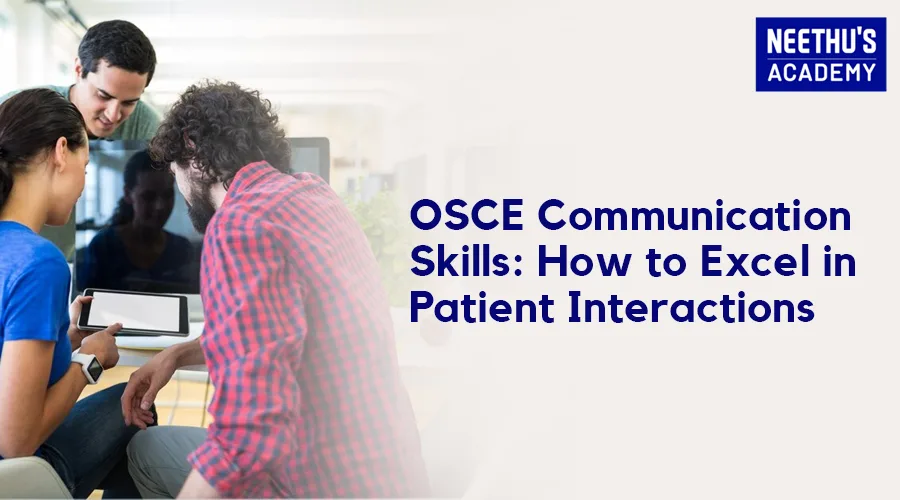How to prepare for the OSCE Exam and Pass with Flying Colors
Most medical students need to attend a very tough and intense practical exam as part of their final year exams or for practicing in European countries or the UK. It is a thorough Examination specifically designed to analyze your clinical competence. In the case of working abroad, scoring well in the OSCE Exam can help you to a great extent as it helps you gain your professional license. As the test puts huge focus on practical skills and patient interaction, preparation for the Exam can be very challenging. In this blog, we’ll explore OSCE Exam preparation tips, tips for managing your time wisely, and how to get a perfect score! Let’s see how it’s done.
What is OSCE?
The Objective Structured Clinical Examination is a comprehensive assessment that seeks to check the candidates on clinical, communication, and decision-making skills in real-world healthcare settings. This multi-station exam presents candidates with various clinical scenarios in which they are required to apply their skill set in real-world practice.
An OSCE Exam might involve conducting physical examinations, during which you are expected to exhibit anatomy knowledge and clinical techniques. You may also be asked to give patient care advice in order to test your communication skills to ensure the patient has clear knowledge about his or her condition and the treatment available. The assessment of a patient’s condition based on the symptoms presented requires analysis, critical thinking, and clinical reasoning.
Candidates may also be asked to demonstrate appropriate use of medical equipment available to them. This is an example of technical skill and ability to maintain safety protocols. The overall idea behind the OSCE is to check whether you are not only knowledgeable but competent as well in applying that knowledge practically and confidently. This format is critical to healthcare education because it creates a difference between theoretical learning and the application of real-life situations. This ensures that candidates are well prepared for the complexities that deal with patient care within their subsequent careers in medicine.
Score Calculation in the OSCE Exam
The OSCE scoring procedure incorporates several key aspects that help in overall assessment of a candidate’s abilities. One of the major methods is checklists. In this context, assessors mark off a checklist of specific actions of candidates who perform the appropriate steps involved in clinical procedures or appropriate questions asked during interactions with patients. Normally, a clear outlining of the parameters on which the candidates are going to be judged is provided to each station, thus giving a structured framework for the evaluation process.
Additionally, the OSCE also uses a Global Rating Scale. This holistic approach makes it easier for the examiner to assess a candidate’s global performance in each station not only in terms of technical skills but also communication and interpersonal skills. The system recognizes soft skills as a part of healthcare and emphasizes the need for patient as well as colleague interaction for candidates. Globally, rating and checklist-based assessment in OSCE ensure the competencies required in practice are evaluated without any holes or gaps.
Passing Score in the OSCE Exam
The passing score varies institution by institution and even country to country. In most, a mark of 60-70% is a pass, though, in some countries such as the UK, cut-offs will differ between each of the four stations. Double-check before your exam what the requirements are because institutions may have set their benchmarks.
Scoring Criteria in the OSCE Exam
Clinical skills stations: These usually involve checklist-type activities. You may have tasks like taking an extensive history or doing a physical exam. Sometimes you may be assigned to demonstrate some kind of procedure. Each task has some point value, so at the end of the day, you will be scored for all that you have accomplished.
Communication or counseling stations: This might include a global assessment of the effectiveness of how you communicate with the patient. Here, there is a concern to see whether you have nice rapport skills, show empathy and clear explanation.
Diagnostic stations: These will assess the decision you would make for the symptom in question. You could be asked to interpret test results or make treatment recommendations. How you justify your clinical reasoning will have much to do with your grading.
How to Manage Time in the OSCE Exam
If you aim to pass the OSCE Exam in the first attempt, then it’s important to manage your time as each station will last only about 5 – 10 minutes.
Plan Quickly
On entering the station, study the task and mentally rehearse what you need to do before you start. For instance, if the station requires you to conduct a physical examination, allocate a few seconds to mentally outline the key components you need to do-including consent, explanation, and then execution without wasting unnecessary time.
Focus on A Few Essential Tasks
It helps you determine what’s most relevant to do first, like getting consent, explaining procedures, or doing key physical exams. For example, if you’re being asked to perform a head-to-toe assessment, you should address which is most salient to the clinical scenario presented.
Don’t hurry
Even though the duration is tight, don’t let speed compromise quality. Stay composed and mistake-free. Timed practice conditions will help you develop a feeling of pacing that balances thoroughness with efficiency.
Use a Watch or Timer
If you are allowed, count down the clock at every station. This will help you keep track because it is easy to lose track when moving from one station to another. Having a mental marker for when it is time to start wrapping things up can help keep things on track.
Is Dress Code Important for the OSCE Exam?
Candidates often underestimate the dress code while taking the OSCE Exam. But it does significantly affect your overall performance.
Business Attire
Be dressed professionally, such as you would in a clinical setting. This not only gives confidence but also presents a good impression to examiners. Business casual would probably be the recommended attire but do make sure you check specific guidelines for your institution.
Neat and clean
A clean look shows professionalism. Avoid flashing accessories and perfumes. Also, avoid anything that tends to take away all the attention from your performance. Simple hairstyles and minimum makeup help keep the environment on track.
Wear your ID Badge
Always wear your identification badge at all times because, in clinical settings, it is expected to be there. In this way, you will not take each other lightly as a candidate, and the examiners will treat you respectively.
How To Pass the OSCE Exam in the first Attempt
Practice Clinical Scenarios: You can practice OSCE stations with fellow students or instructors to get better accustomed to the structure and more confident by using actual scenarios in your practice.
Review Guidelines and Procedures: Keep updating yourself about clinical guidelines, especially those you will commonly find in the OSCE. Be aware of the variations at a local level as a student in India or the UK.
Mock Exams: Take timed mock exams to learn to make good use of your time and know which subjects require more practice.
Seek feedback: Regularly seek a response from a tutor or peer to make improvements in your technique as well as in error correction.
Join Study Groups: Try to join a study group as much as possible; it might give you different views and keep you focused.
Communicate: Do not forget to practice your oral skills; communication is the way to OSCE success.
Final Thoughts
To score well in the OSCE Exam you need to understand the exam pattern, manage time efficiently, stick to a professional dress code, and practice real-life scenarios. Following these steps will definitely aid you in getting a high score in the Exam. A well-sought-out preparation strategy is key to passing any Exam. By employing effective study strategies, regular practice, and maintaining professionalism, you can overcome the hurdles of the OSCE Exam with ease. Remember, the journey is as important as the destination! Each practice and mock test makes you ready for the real exam. One step at a time you will be closing the gap between your dream score. Keep going and wishing you all the best!
Frequently Asked Questions





